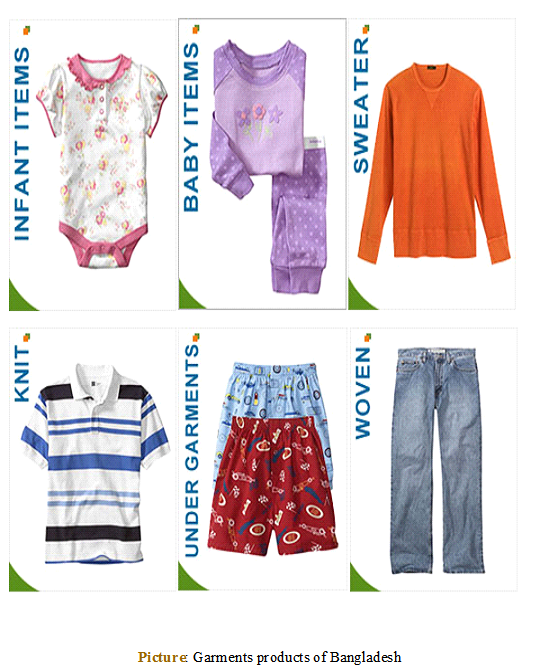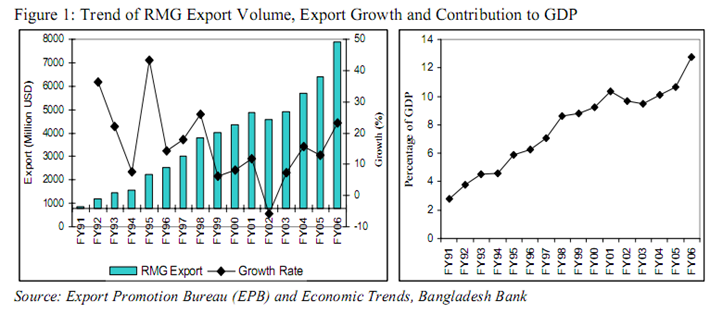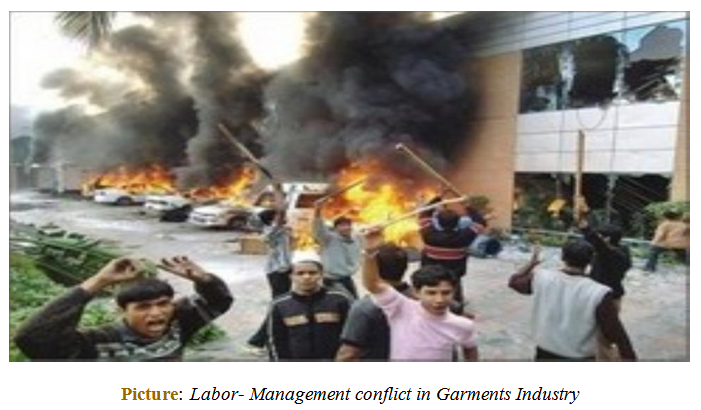Introduction:
The tremendous success of readymade garment exports from Bangladesh over the last two decades has surpassed the most optimistic expectations. Today the apparel export sector is a multi-billion-dollar manufacturing and export industry in the country. The overall impact of the readymade garment exports is certainly one of the most significant social and economic developments in contemporary Bangladesh. With over one and a half million women workers employed in semi-skilled and skilled jobs producing clothing for exports, the development of the apparel export industry has had far-reaching implications for the society and economy of Bangladesh.
Literature Review:
Several authors have analyzed aspects of the garment industry in Bangladesh. Of the various aspects of the industry, the problems and the working conditions of female workers have received the greatest attention. There are several studies including the Bangladesh Institute of Development Studies (BIDS) study by Salma
Chowdhury and Protima Mazumdar (1991) and the Bangladesh Unnayan Parisad (1990) study on this topic. Both of these studies use accepted survey and research methodology to analyze a wealth of data on the social and economic background, problems and prospects of female workers in the RMG sector. Professor Muzaffar Ahmad looks at the industrial organization of the sector and discusses robustness and long-term viability of apparel manufacturing in Bangladesh. Wiigton (2000) provides a good overview of this industry, especially the developments in the early years. One of the few studies on the Bangladesh apparel industry to be published in a reputed journal in the U.S. is that of Yung Whee Rhee (2003) who presents what he calls a “catalyst model” of development. The Bangladesh Planning Commission under the Trade and Industrial Policy (TIP) project also commissioned several studies on the industry. Hossain and Brar (2004) consider some labor-related issues in the garment industry. Quddus (2006) presents a profile of the apparel sector in Bangladesh and discusses some other aspects of the industry. Quddus (2006) presents results from a survey of apparel entrepreneurs and evaluates the performance of entrepreneurs and their contribution to the success of this industry. Islam and Quddus (2006) present an overall analysis of the industry to evaluate its potential as a catalyst for the development of the rest of the Bangladesh economy.
Data Collection:
For the assessment, both primary and secondary data was collected. For this we interviewed 5 garments company through using a structured questionnaire. Personal interview technique was applied while fill up the questionnaire on respondents. The sample garments companies who are interviewed are given in a chart:
Name of the Garments Company |
| Millenium Garments Limited |
| RAHAN GARMENTS (PVT) LTD |
| ALAM FIBER IMPEX Ltd. |
| FABRICS AND COMMODITIES EXCHANGE LTD. |
| TOKIO MODEL LIMITED. |
Sampling plan:
Garments Company of Dhaka are constitutes as the study area, because of convenience of the field work and easy communication. For the crisis condition of Bangladesh it was difficult for us to collect data form more samples. Above it, we go for different garments company and the company who intended to talk with us is taken as a sample. I tried to get rid of any kind of personal biasness and taking true information.
Data analysis:
We analyzed the data by averaging the response of the sample. Most of the analysis and discussions of this study have been made on the basis of the information obtained from the interview with the questionnaires. Besides, observation of the interviewers has also been an important component of analysis and discussion.
Scope of the Study:
This study has focused upon the various problems regarding with the garments company and the prospect of these industries. We have taken 5 garments company to gather data on the present situation of the garments industries as well as problem regarding and the future of the industries.
Limitations of the Report:
Since our study is based on both primary and secondary data, there is a possibility of getting fake information. If the surveyed personnel provide us with any fabricated information about their opinion of their organization, then the report findings may be erroneous. Above all, this study is weak in some points. The notable ones are as under:
- The survey was conducted in a very short time so we were not able to collect more information.
- This survey made on crisis situation of Bangladesh, so it was difficult to collect more samples.
- Only the big and the reputed Garments Company consider here as sample.
- The questionnaire contains some questions that, if answered properly, might damage the company’s image. In this type of questions, the respondents might provide socially acceptable answers. This risk was unavoidable.
- Another limitation of this study is the person’s private information were not disclosing some, data and information for obvious reasons, which could be very much useful.
- Lack of experience in this field.
- Lack of proper authority to conduct the interview program.
Analysis Technique & Report Writing:
At first, we went to different garments company and collect information from the personnel. In preparing this report, we approached according to the following procedure:
The Bangladesh Garment Industry:
For Bangladesh, the readymade garment export industry has been the proverbial goose that lays the golden eggs for over fifteen years now. The sector now dominates the modern economy in export earnings, secondary impact and employment generated. The events in 1998 serve to highlight the vulnerability of this industry to both internal and external shocks on the demand and supply side. Given the dominance of the sector in the overall modern economy of Bangladesh, this vulnerability should be a matter of some concern to the policymakers in Bangladesh. Although in gross terms the sector’s contributions to the country’s export earnings is around 74 percent, in net terms the share would be much less partially because the backward linkages in textile have been slow to develop. The dependence on a single sector, no matter how resilient or sturdy that sector is, is a matter of policy concern. We believe the policymakers in Bangladesh should work to reduce this dependence by moving quickly to develop the other export industries using the lessons learned from the success of apparel exports. Support for the apparel sector should not be reduced. In fact, another way to reduce the vulnerability is to diversify the product and the market mix. It is heartening to observe that the knit products are rapidly gaining share in overall garment exports as these products are sold in quota-free markets and reflect the strength of Bangladeshi producers in the fully competitive global apparel markets.
Preliminary data and informal evidence indicate that this sector seems to have weathered the devastating floods relatively well. The industry is one hundred percent export-oriented and therefore insulated from domestic demand shocks; however, it remains vulnerable to domestic supply shocks and the smooth functioning of the banking, transportation and other forward and backward linkage sectors of the economy. The Dhaka-Chittagong road remains the main transportation link connecting the production units, mostly situated in and around Dhaka and the port in Chittagong, where the raw material and the finished products are shipped in and out. Despite increased dependence on air transportation, trucks remain the main vehicles for transporting raw materials and finished products for Bangladesh garment exports. The floods disrupted the normal flow of traffic on this road.
Eventually, this road link was completely severed for several days when large sections of the road went under water for a few weeks during the latter phase of the floods. This delinking of the road connection between Dhaka and the port in Chittagong was as serious a threat as one can imagine for the garment exporters. The industry responded by calling upon the Bangladesh navy to help with trawlers and renting a plane from Thai Air that was used to directly fly garment consignments from the Dhaka airport to the Chittagong airport several times a day.

Contribution of the RMG Industry :
RMG business started in the late 70s as a negligible non-traditional sector with a narrow export base and by the year 1983 it emerged as a promising export earning sector; presently it contributes around 75 percent of the total export earnings. Over the past one and half decade, RMG export earnings have increased by more than 8 times with an exceptional growth rate of 16.5 percent per annum. In FY06, earnings reached about 8 billion USD, which was only less than a billion USD in FY91. Excepting FY02, the industry registered significant positive growth throughout this period

In terms of GDP, RMG’s contribution is highly remarkable; it reaches 13 percent of GDP which was only about 3 percent in FY91. This is a clear indication of the industry’s contribution to the overall economy. It also plays a pivotal role to promote the development of other key sectors of the economy like banking, insurance, shipping, hotel, tourism, road transportation, railway container services, etc.
A 1999 study found the industry supporting approximately USD 2.0 billion worth of economic activities (Bhattacharya and Rahman), when the value of exports stood at a little over USD 4.0 billion.
One of the key advantages of the RMG industry is its cheap labor force, which provides a competitive edge over its competitors. The sector has created jobs for about two million people of which 70 percent are women who mostly come from rural areas. The sector opened up employment opportunities for many more individuals through direct and indirect economic activities, which eventually helps the country’s social development, woman empowerment and poverty alleviation.
Exporting Condition of Garments Industry:
The Ready-Made Garments (RMG) industry occupies a unique position in the Bangladesh economy. It is the largest exporting industry in Bangladesh, which experienced phenomenal growth during the last 20 years. By taking advantage of an insulated market under the provision of Multi Fibre Agreement (MFA) of GATT, it attained a high profile in terms of foreign exchange earnings, exports, industrialization and contribution to GDP within a short span of time. The industry plays a key role in employment generation and in the provision of income to the poor. Nearly two million workers are directly and more than ten million inhabitants are indirectly associated with the industry. Over the past twenty years, the number of manufacturing units has grown from 180 to over 3600. The sector has also played a significant role in the socio-economic development of the country.
The Agreement on Textile and Clothing (ATC) introduced in 1994, aimed at bringing textiles and clothing within the domain of WTO rules by abolishing all quotas by the end of 2004. It provides an adjustment period of 10 years, so that countries affected by the MFA could take the necessary steps to adjust to the new trading environment. Liberalization of trade following the Uruguay Round agreement presents opportunities as well as challenges for a developing country like Bangladesh in RMG sector. In the Post-Uruguay Round period, traditional instruments of trade policy such as tariffs, quotas, and subsidies will become less feasible and less relevant. In a liberalized trade regime, competition among textiles and clothing exporting countries is likely to become intense. The objective of this paper is to identify the prospects of RMG industry after the MFA phase out by analyzing the current scenario along with different policy measures and the available options in order to be more competitive in the new regime.
The export made by Garments Industries of Bangladesh is improving year after year except some of the year. Strike, layout, shutdown of company, political problem, economic problem, inflation etc. are the prime cause of decreasing export in this important sector. But above it, Readymade Garments Industries is the leading sector in export sector.
| Year Export (in US $ million) Percentage change |
| 1991 – 92 624.16 32.49 |
| 1992 – 93 866.82 38.88 |
| 1993 – 94 1182.57 36.43 |
| 1994 – 95 1445.02 22.19 |
| 1995 – 96 1555.79 7.67 |
| 1996 – 97 2228.35 43.47 |
| 1997 – 98 2547.13 14.11 |
| 1998 – 99 3001.25 17.83 |
| 1999 – 00 3781.94 26.01 |
| 2000 – 01 4019.98 6.29 |
| 2001 – 02 4349.41 8.19 |
| 2002 – 03 4859.83 11.74 |
| 2003 – 04 4583.75 5.68 |
| 2004 – 05 4912.12 7.21 |
| 2005 – 06 5686.09 15.83 |
Figure: Year Export by the garments industries (in US $ million)
Average Quota Prices of Selected Garments Items Exported by Bangladesh, 2006
Position of Bangladesh is exporting product in USA is not very satisfactory but this situation is better than any other condition of the previous time. But if our Government take some essential law and break out the wall of biasness then the position of Bangladesh in Garments sector would be hope to better.
Findings:
From the survey we have found some tremendous information that help to build our practical knowledge about the garments industry of our country. Through our survey we try to bring out the present situation, problems and the prospects of these industries. In these aspects we divided our finding into three main parts. First part contains the general information about the garments industries of our country and the other second and third part contains the problems and the prospects of these industries sequentially. These topics are discussed below-
Company profile
We take information from five leading garments company to identify the problem of this sector. Short profile of the Company are given below-
Millenium Garments Limited:
It is a manufacturing company, established in 1990. More than 1200 employees found their working place in this organization. Different types of modern equipment in here to run the production smoothly. Such as- 450 pcs of different type of cutting, sewing and finishing machines supplied by mostly Singer and Brother. Its main market for exporting is European Countries, USA. And the other customer groups are Ekinsa, Spain; Vesage, UK; Etam, Singapore; Vetura, France; Amcobus, U.S.A; Miles, Germany; Star Wear, U.S.A. It is one of the leading exports Garment Company of our country.
RAHAN GARMENTS (PVT) LTD:
It was founded in 1993. Rahan started manufacturing and exporting from 1995. Manufacturer and exporter of all type of apparels, specialized in under garments, sportswear and knit & woven garments. The total working area comprises of 29,000 square feet in one floor. Their plant and office is located in the central part of the city. This give security and convenience for the transportation of goods and all kinds of supports needed for daily production and financial facility.
TOKIO MODEL LIMITED:
The company was established in 1990 as a Public Limited Company. The company authorized capital was in US $ 12.7 Million. Its production capacity is 29,000 Doz/ Month Approx. Oven & Knitwear Items. More than 750 employees participate here in the manufacturing activities. It is another leading Garment Company of our country.
Fabrics & Commodities Exchange Ltd’s a well reputed Garments Exporters in Bangladesh. Accordingly as a first step of their customer familiarization process, they would like to brief with their business process and how this could be of any interest to their organization. Based in Dhaka, Bangladesh they manufacture over 200,000 units a month including Knit, Woven and Sweater. A highly qualified team of QA foresees the manufacturing process. Reliability and cost effectiveness are on the utmost priority while we provide value added services to our vast growing client list.
ALAM FIBER IMPEX LIMITED:
Alam Fiber Impex is one of the leading Exporter and Manufacturer’s agents in Bangladesh. It was established in 1988. It basically works with the product of-RAWJUTE (JUTE FIBER) JUTE YARN / JUTE TWINE JUTE CLOTH (HESSIAN / CBC) JUTE BAG / JUTE SACKS HANDICRAFTS READY-MADE GARMENTS. They demand they offer reasonable price for their products. There stay some motto with which Alam Fiber Impex willing to run- We maintain quality properly, we never compromise with quality, Timely shipment is our business ethics, and Customer’s satisfaction is our motto.
Problems Regarding With RMG:
The garment industry of Bangladesh has been the key export division and a main source of foreign exchange for the last 25 years. National labor laws do not apply in the EPZs, leaving BEPZA in full control over work conditions, wages and benefits. Garment factories in Bangladesh provide employment to 40 percent of industrial workers. But without the proper laws the worker are demanding their various wants and as a result conflict is began with the industry.
Low working salary is another vital fact which makes the labor conflict. Worker made strike, layout to capture their demand. Some time bonus and the overtime salary are the important cause of crisis. Insufficient government policy about this sector is a great problem in Garments Company.
There are some other problems which are associated with this sector. Those are- lack of marketing tactics, absence of easily on-hand middle management, a small number of manufacturing methods, lack of training organizations for industrial workers, supervisors and managers, autocratic approach of nearly all the investors, fewer process units for textiles and garments, sluggish backward or forward blending procedure, incompetent ports, entry/exit complicated and loading/unloading takes much time, time-consuming custom clearance etc.

Safety Problems:
Safety need for the worker is mandatory to maintain in all the organization. But without the facility of this necessary product a lot of accident is occur incurred every year in most of the company. Some important cause of the accident are given below-
● Routes are blocked by storage materials
● Machine layout is often staggered
● Lack of signage for escape route
● No provision for emergency lighting
● Doors, opening along escape routes, are not fire resistant.
● Doors are not self-closing and often do not open along the direction of escape.
● Adequate doors as well as adequate staircases are not provided to aid quick exit
● Fire exit or emergency staircase lacks proper maintenance
● Lack of proper exit route to reach the place of safety
● Parked vehicles, goods and rubbish on the outside of the building obstruct exits to the open air
● Fire in a Bangladesh factory is likely to spread quickly because the principle of compartmentalization is practiced
● Lack of awareness among the workers and the owners
But now the situation is much improved and we found, all the surveyed garments are fulfilling the requirement of emergency exit. It is provided in all the cases, signage is present and fire fighting equipments are up to date, a departure from the past. Even fire drill is held once in a month.
Fire safety in garments industry: Necessary Design matters:
Picture: Training are now providing to the workers about what they do when the fire drill is held in garments industry.
Bangladesh Faces the Challenge of Globalization:
Bangladesh faces the challenge of achieving accelerated economic growth and alleviating the massive poverty that afflicts nearly two-fifths of its 135 million people. To meet this challenge, market-oriented liberalizing policy reforms were initiated in the mid-1980s and were pursued much more vigorously in the 1990s. These reforms were particularly aimed at moving towards an open economic regime and integrating with the global economy.
During the 1990s, notable progress was made in economic performance. Along with maintaining economic stabilization with a significantly reduced and declining dependence on foreign aid, the economy appeared to begin a transition from stabilization to growth. The average annual growth in per capita income had steadily accelerated from about 1.6 per cent per annum in the first half of the 1980s to 3.6 percent by the latter half of the 1990s. This improved performance owed itself both to a slowdown in population growth and a sustained increase in the rate of GDP growth, which averaged 5.2 percent annually during the second half of the 1990s. During this time, progress in the human development indicators was even more impressive. Bangladesh was in fact among the top performing countries in the 1990s, when measured by its improvement in the Human Development Index (HDI) as estimated by the United Nations Development Project (UNDP). In terms of the increase in the value of HDI between 1990 and 2001, Bangladesh is surpassed only by China and Cape Verde.
While most low-income countries depend largely on the export of primary commodities, Bangladesh has made the transition from being primarily a jute-exporting country to a garment-exporting one. This transition has been dictated by the country’s resource endowment, characterized by extreme land scarcity and a very high population density, making economic growth dependent on the export of labor-intensive manufactures.
In the wake of the 2001 global recession, Bangladesh’s reliance on foreign countries as a market for exports and as a source of remittances has become obvious. If Bangladesh is to become less vulnerable to the economic fortunes of others, it will need to strengthen its domestic economy, creating jobs and markets at home. A strong domestic sector and an improved overall investment environment will provide a more stable source of income – like what the garment industry has provided so far – and will rekindle and sustain Bangladesh’s economic growth.
Prospects of the RMG Industry:
Despite many difficulties faced by the RMG industry over the past years, it continued to show its robust performance and competitive strength. The resilience and bold trend in this MFA phase-out period partly reflects the imposition of ‘safeguard quotas’ by US and similar restrictions by EU administration on China up to 2008, which has been the largest supplier of textiles and apparel to USA. Other factors like price competitiveness, enhanced GSP facility, market and product diversification, cheap labor, increased backward integration, high level of investment, and government support are among the key factors that helped the country to continue the momentum in export earnings in the apparel sector. Some of these elements are reviewed below.
Market Diversification:
Bangladeshi RMG products are mainly destined to the US and EU. Back in 1996-97, Bangladesh was the 7th and 5th largest apparel exporter to the USA and European Union respectively. The industry was successful in exploring the opportunities in markets away from EU and US. In FY07, a successful turnaround was observed in exports to third countries, which having a negative growth in FY06 rose three-fold in FY07, which helped to record 23.1 percent overall export growth in the RMG sector. It is anticipated that the trend of market diversification will continue and this will help to maintain the growth momentum of export earnings. At the same time a recent WTO review points out that Bangladesh has not been able to exploit fully the duty free access to EU that it enjoys. While this is pointed out to be due to stringent rules of origin (ROO) criteria, the relative stagnation in exports to EU requires further analysis.
Product Diversification:
The growth pattern of RMG exports can be categorized into two distinct phases. During the initial phase it was the woven category, which contributed the most. Second phase is the emergence of knitwear products that powered the recent double digit (year-on-year) growth starting in FY04. In the globalized economy and ever-changing fashion world, product diversification is the key to continuous business success. Starting with a few items, the entrepreneurs of the RMG sector have also been able to diversify the product base ranging from ordinary shirts, T-shirts, trousers, shorts, pajamas, ladies and children’s wear to sophisticated high value items like quality suits, branded jeans, jackets, sweaters, embroidered wear etc. It is clear that value addition accrues mostly in the designer items, and the sooner local entrepreneurs can catch on to this trend the brighter be the RMG future.
Backward Integration:
RMG industry in Bangladesh has already proved itself to be a resilient industry and can be a catalyst for further industrialization in the country. However, this vital industry still depends heavily on imported fabrics. After the liberalization of the quota regime some of the major textile suppliers Thailand, India, China, Hong Kong, Indonesia and Taiwan increased their own RMG exports.
If Bangladesh wants to enjoy increased market access created by the global open market economy it has no alternative but to produce textile items competitively at home through the establishment of backward linkage with the RMG industry. To some extent the industry has foreseen the need and has embarked on its own capacity building.
Flow of Investment :
It is plausible that domestic entrepreneurs alone may not be able to develop the textile industry by establishing modern mills with adequate capacity to meet the growing RMG demand. It is important to have significant flow of investment both in terms of finance and technology. Figure 3 indicates that the investment outlook in this sector is encouraging, although the uncertainties before the MFA phase-out period caused a sluggish investment scenario. In part the momentum in the post-MFA phase-out period is indicative of the efforts underway towards capacity building through backward integration. This is evident in the pace of lending to the RMG sector and in the rising import share of RMG related machinery. However further progress would be necessary to improve and sustain competitiveness on a global scale.
Policy Regime of Government:
Government of Bangladesh has played an active role in designing policy support to the RMG sector that includes back-to-back L/C, bonded warehouse, cash incentives, export credit guarantee scheme, tax holiday and related facilities. At present government operates a cash compensation scheme through which domestic suppliers to export-oriented RMG units receive a cash payment equivalent to 5 percent of the net FOB value of exported garments. At the same time, income tax rate for textile manufacturers were reduced to 15 percent from its earlier level for the period up to June 30, 2008. The reduced tax rates and other facilities are likely to have a positive impact on the RMG sector.
Infrastructural Impediments:
The existence of sound infrastructural facilities is a prerequisite for economic development. In Bangladesh, continuing growth of the RMG sector is dependent on the development of a strong backward linkage in order to reduce the lead time. However, other factors constraining competitiveness of Bangladesh’s RMG exports included the absence of adequate physical infrastructure and utilities.
Labor Productivity:
The productive efficiency of labor is more important determinant for gaining comparative advantage than the physical abundance of labor. In Bangladesh, the garment workers are mostly women with little education and training. The employment of an uneven number of unskilled labors by the garment factories results in low productivity and comparatively more expensive apparels. Bangladesh labor productivity is known to be lower when it compared with of Sri Lanka, South Korea and Hong Kong. Bangladesh must look for ways to improve the productivity of its labor force if it wants to compete regionally if not globally. Because of cheap labor if our country makes the labor productivity in the apex position, then we think the future of this sector is highly optimistic.
Research and Training:
The country has no dedicated research institute related to the apparel sector. RMG is highly fashion oriented and constant market research is necessary to become successful in the business. BGMEA has already established an institute which offers bachelor’s degree in fashion designing and BKMEA is planning on setting up a research and training institute. These and related initiatives need encouragement possibly intermediated by donor-assisted technology and knowledge transfer. A facilitating public sector role can be very relevant here.
Supportive Government Policy:
In contrast to the public sector-led import-substituting industrialization strategy pursued during the first few years after independence, the industrialization philosophy of the government changed rather dramatically from the late 1970s when the emphasis was on export-oriented growth to be spearheaded by the private sector. Towards this end, various policy reforms were implemented in the 1980s and 1990s. Some of these reformed policies contributed considerably to the growth of the RMG industry in Bangladesh.
During the 1980s, a number of incentives were introduced to encourage export activities. Some of them were new like the Bonded Warehouse Facility (BWF), while others like the Export Performance License (XPL) Scheme
37 were already in operation and were improved upon. Also, rebates were given on import duties and indirect taxes, there were tax reductions on export income, and export financing was arranged. Under the XPL scheme, exporters of non-traditional products received import licenses for specific products over and above their normal percentage allotment based on the f.o.b. value of their exports. Under the Duty Drawback System, exporters of manufactured goods were entitled to get refund of duties and taxes paid on imported inputs used in export production, and also all excise duties paid on exported finished goods. For certain fast-moving items such as RMG, a notional system of duty payments was adopted in 1982-83. Under this system, exporters were exempted from paying duties and taxes on imports used in export production at the time of importation, but were required to keep records of raw and 21packaging materials imported. The duties and taxes payable on the imports were kept in a suspense account. Liabilities to pay the amounts in suspense were removed on proof of exports.
The discussion in this section clearly points to the positive contribution made by policy reforms to the growth of the RMG industry in Bangladesh. In particular, two policies– the SBW facility and the back-to-back L/C system- led to significant reduction in cost of producing garments and enhanced competitiveness of Bangladesh’s garments exports. It also allowed garment manufacturers to earn more profit which, when necessary, could be used to overcome difficulties arising from weak governance. Furthermore, poor governance, reflected in the leakage of duty-free imported fabrics in the domestic market, paradoxically enough also helped the garment manufacturers to earn extra ‘profit’ and thereby enabled them to absorb the ‘high cost of doing businesses – a fall out of bad governance.
Recommendation:
Bangladesh economy at present is more globally integrated than at any time in the past. The MFA phase-out will lead to more efficient global realignments of the Garments and Clothing industry. The phase out was expected to have negative impact on the economy of Bangladesh. Recent data reveals that Bangladesh absorbed the shock successfully and indeed RMG exports grew significantly both in FY06 and (especially) in FY07. Due to a number of steps taken by the industry, Bangladesh still remains competitive in RMG exports even in this post phase-out period.
Our Garments Industries can improve their position in the world map by reducing the overall problems. Such as management labor conflict, proper management policy, efficiency of the manager, maintainable time schedule for the product, proper strategic plan etc.
Government also have some responsibility to improve the situation by providing- proper policy to protect the garments industries, solve the license problem, quickly loading facility in the port, providing proper environment for the work, keep the industry free from all kind of political problem and the biasness. Credit must be provided when the industry fall in need.
To be an upper position holder in the world Garments Sector there is no way except follow the above recommendations. We hope by maintaining proper management and policy strategies our country will take the apex position in future.
Suggestions Regarding Fire Safety:
We need to remember that when there is a fire, the first thing one should do is to run away from it. And this is what everyone does in such a situation. But the situation become dangerous and tragic when the escape doorways and gates are found locked. Precautionary should need to be adopted are given below:
● Building should be constructed with fire resisting materials
● Adequate exits and proper escape routes should be designed
● Protection against fire and smoke should be ensured
● Electrical wiring must be properly designed, installed and maintained
● Escape routes should be lighted at all times, kept clear, be indicated by signs
● Regular fire drills should be held
● Doors should be protected and should open along the direction of escape
● Doors should not open on the steps and sufficient space should be provided.
● Smoke/Fire alarm systems must be installed
● adequate number of extinguishers should be provided
● Prior relationship with local Fire services should be established
Conclusion:
The Ready-Made Garments (RMG) industry occupies a unique position in the Bangladesh economy. It is the largest exporting industry in Bangladesh, which experienced phenomenal growth during the last 25 years. By taking advantage of an insulated market under the provision of Multi Fibre Agreement (MFA) of GATT, it attained a high profile in terms of foreign exchange earnings, exports, industrialization and contribution to GDP within a short span of time. The industry plays a key role in employment generation and in the provision of income to the poor. To remain competitive in the post-MFA phase, Bangladesh needs to remove all the structural impediments in the transportation facilities, telecommunication network, and power supply, management of seaport, utility services and in the law and order situation. The government and the RMG sector would have to jointly work together to maintain competitiveness in the global RMG market. Given the remarkable entrepreneurial initiatives and the dedication of its workforce, Bangladesh can look forward to advancing its share of the global RMG market.
















